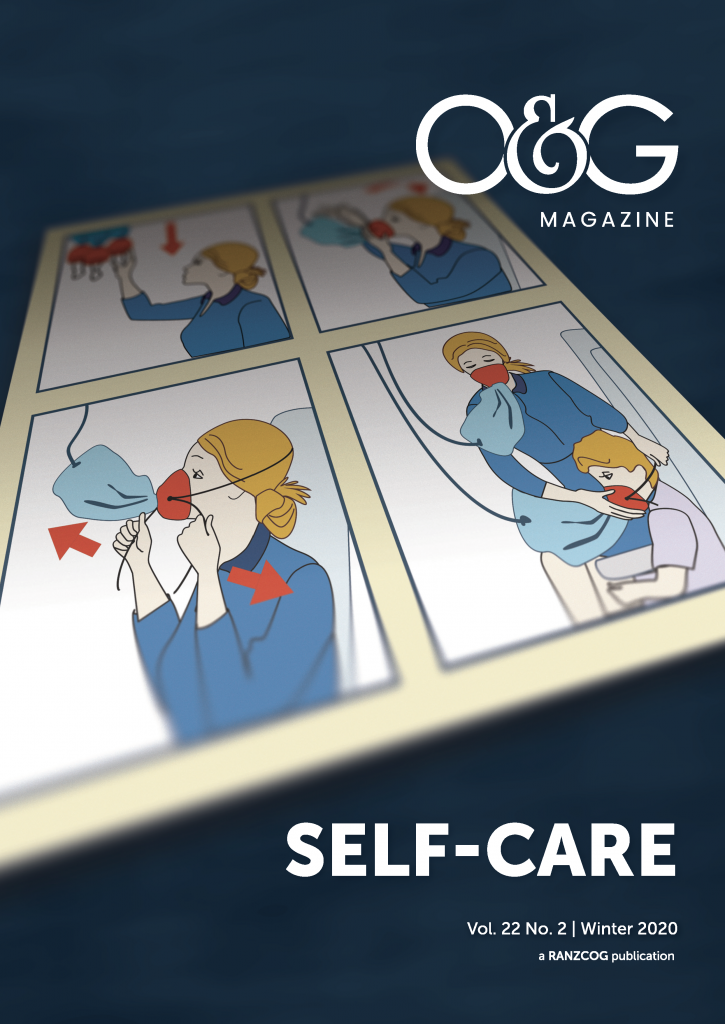The following case occurred at the Cohuna District Hospital. We have a level 2 obstetric unit and refer more complex cases to Bendigo Base Hospital, 130km south over a rural road network. If on bypass (usually four days a month due to unavailability of a full theatre team) cases fitting our capability framework are referred to Echuca, 60km east via a rural highway.
Case description
K, 29 years old, A negative, G2P1 at 37 weeks gestation, presented as a fully dilated obstructed breech while the hospital was on bypass.
In her first pregnancy in 2017, K presented in early labour, also at 37 weeks when we were on bypass. 178cm tall with a BMI of 26, she had no medical problems. She was transferred to Echuca for management. Her slow progress resulted in an epidural and an oxytocin infusion. 12 hours later, she had a failed instrumental delivery and an emergency lower uterine segment caesarean (LUSC). The fetal head was impacted, and the uterus was friable. The LUSC took three hours, there was a tear into the lower segment and 1500ml blood loss. Resuscitation included blood, but mother and baby were transferred back to Cohuna the next day and recovered well.
This pregnancy was red flagged. The regional team booked K at Bendigo Base Hospital for an elective LUSC at 39 weeks gestation.
K had antenatal care in Cohuna with a planned review in Bendigo near 39 weeks. At 36 weeks, a scan found an engaged frank breech with a fundal placenta. Communication to the Base Hospital gave a revised plan: if she came into labour in Cohuna, refer her urgently, but if she was in established labour, we should deliver her in Cohuna by LUSC. As the baby was well grown and there were no maternal illnesses, the planned 39 week LUSC was reasonable.
K woke contracting and presented at Cohuna at 0130 for assessment. We were on bypass. K was fully dilated with the breech at spines. Given she had been in labour for one hour, and at 37 weeks, it seemed delivery was eminent. I discussed with the regional obstetrician and she concurred it was too dangerous to move her as we may be caught with an undeliverable aftercoming head in transit.
A theatre team was called. There was a GP obstetrician and two GPs to assist, but no anaesthetist. An anaesthetist not on call was contacted. He confirmed he was coming at 0215.
A decision pathway was set up consulting all staff. We used the planning process from PROMPT training to define roles and teams. K continued to contract but there was no fetal distress and no progression.
Plan A: Wait for the anaesthetist then perform emergency LUSC, but if fetal distress or impending delivery, proceed to plan B.
Plan B: The GP proceduralist to insert spinal and hand over to the anaesthetic nurse and proceed to LUSC. This plan was not a preferred option, but K was taken to theatre and everything set for an immediate LUSC. Theatre staff scrubbed and the rest of the team were called in. K lay on the theatre table from 0235 with two 16g IVs inserted and was preloaded with 600ml saline and given cefazolin 2g (GBS neg) and anti-reflux medication, plus 25mg IV pethidine for her pain. Tocolysis was discounted as there was no fetal distress. 4 units of O negative blood were available.
Plan C: Transfer by ambulance (had already been abandoned as most likely to have poor outcomes).
The anaesthetist arrived before a need for Plan B. Surgery commenced at 0320 under spinal. All layers were scarred and adherent. The bladder reflection needed sharp dissection. The uterus was opened transversely using fingers to stretch the incision. The impacted breech was delivered, but the shoulders were held tightly in the muscular upper segment in a constriction ring. The shoulders and arms delivered with Loveset’s manoeuvre, but the head could not be delivered with direct traction, extending the fetus over the uterus or the Mauriceau-Smellie-Veit manoeuvre. A hand under the fetal head with external pressure on the uterus allowed delivery of the head. Baby was stunned but rapidly recovered. Arterial cord lactate was 2.5, Apgars were 6, 8 and 9, four minutes CAP were need. The placenta delivered spontaneously as oxytocin 10u was given IV.
The uterine incision tore into the left side of the uterus with brisk arterial bleeding. The bleeding area was packed while the original incision was closed with a 1/0 caprosyn suture. The left side of the wound was then lifted using the first suture end and the 4cm long extension wound identified. This was sewn through and through with traction maintained on the suture line, tying it off once bleeding controlled. The rest of closure was routine. Blood loss was 600ml. Pre-op Hb was 122. Next day Hb was 114. 3L of normal saline was given, two post-op to keep bladder flushed. The urine drained by the pre-op catheter was clear, but post-op was heavily blood stained. This cleared over 24 hours. The regional obstetrician suggested a cystogram. There was no leakage outside of the bladder on cystogram 30 hours post-op, so catheter was removed.
A Keilhauer test showed a 29ml fetal-maternal haemorrhage, fetal blood group was A negative. Fetal Hb was 13. Neonatal blood sugar was 1.6 at two hours and baby had a single dose of glucose gel and an early formula feed. Sugars remained in range and the baby was nursed in a humidicrib for four hours. Care from there was normal. Mother and baby went home on day 4.
Discussion points for comment
- We identified this as a high-risk case antenatally with an appropriate delivery plan at a base hospital, but no plan to care for this lady close to appropriate care once she was at term. Were her risks elevated by previous 37 week labour, breech and PH of obstruction? Should term women be offered accommodation close to the planned site of care? Expectant mother more than 50k from the hospital providing care are at increased risk of roadside delivery and adverse outcomes.1 Guidelines2 suggest elective LUSC delivery at 39 weeks is appropriate but these guidelines do not take into account distance from care or how emergency delivery before 39 weeks will be dealt with locally.
- The constriction ring found at LUSC was not appreciated prior to surgery. K had pain and a prominent fundal bulge with full dilation
and failure of descent of the presenting part; this is a classical but forgotten sign of obstructed breech.3 4 5 - Training in managing a constriction ring isn’t easy to find.6 Options include a planned classical LUSC (a fundal placenta made this unattractive) or a T incision. The manual disimpaction I used (similar to the technique for a retained placenta with a hand deep in uterus sliding under the head and pressure applied externally to the internal hand rather than the head) is not previously described. This was successful but caused a traumatic placental separation as indicated by the 29ml fetal-maternal transfusion.
- Management of the lateral wall tear by traction on the primary closure suture identified the extent of the tear and allowed successful control of bleeding. If I had been unsuccessful, my options would have included packing and transferring to the base hospital by ambulance or a sub-total hysterectomy. Remember this was at 0330 in Cohuna.
- Management of traumatic macroscopic haematuria was by leaving a catheter in situ until cystogram performed but without cystoscopy. What is the standard?
Conclusion
This case illustrates issues facing rural GPs in planning and implementing care for high-risk patients with limited resources. There are issues in dealing with unexpected complexities that I thought might provoke others to discuss how they would manage this in their region.
Commentary from Dr Jared Watts
This case demonstrates the difficult and challenging work rural GP obstetricians often face. Even with the best planning, often high-risk cases can occur in these limited resource settings. There is a concern that this may occur more often now as smaller rural maternity units are closed, but this does have to be balanced with being able to adequately staff all country units. Dr Barker and his team excelled in calling in all available resources and personnel, considering all available options and they had previously trained as a team with a PROMPT course. All these activities assisted in leading to the final excellent outcome for the patient who had a very complicated delivery.
Often in these settings, we need to return to the basics, as this team did. Packing has been demonstrated to achieve haemostasis both in the short term while calling for assistance or it can be used while transferring patients to another unit. It is tempting to transfer undelivered patients quickly in such situations to higher resource centres, but this can place the patient and staff at even higher risk if the patient delivers outside of a hospital setting. Bandl’s rings are reported to be rare but are potentially increasing and therefore research and training modules needs to be developed regarding the approach a surgeon should take in such situations. Interestingly, noting how rarely surgeons encounter Bandl’s rings, Gupta et al have developed a model from simple home supplies they use for training in such situations.7
This case also highlights another challenge that is often raised to CCDOG Committee. Many tertiary and larger regional hospitals kindly take GP obstetricians for upskilling, in particular for caesarean sections. This is a fantastic opportunity for rural and remote GPs to maintain and further develop their skills. Often, however, they report that if a case has some complication such as a placenta praevia, twins or it is a patient’s fourth or fifth caesarean, they are asked to stand aside as ‘you won’t do this type of delivery in the country.’ This is true, we try and relocate all moderate to high-risk patients to larger units prior to delivery, but as this case demonstrates, this sometimes does not happen as patients may labour early or the complication is not diagnosed until they are in labour. The GP obstetrician is then often left managing this patient on their own, with extremely limited resources and local supports.
So next time you have a GP upskilling with you, we urge you to get them involved in these more difficult cases. Teach them about what to do with a placenta praevia, how to get that back down, transverse baby out at caesarean section or how to get into an abdomen of a woman with five previous laparotomies safely and quickly. At our unit, we get our GP obstetricians to also assist with abdominal hysterectomies, just in case they need these skills one day in a remote area. By teaching a GP obstetrician these skills, there is a high chance that one day, thanks to your teaching, a life may be saved in a rural or remote area.
References
- Guardian Newspaper. Queensland’s rise in baby deaths after closure of rural obstetric unit sparks rethink. 12 August 2018. Available from: www.theguardian.com/australia-news/2018/aug/12/queenslands-rise-in-baby-deaths-after-obstetric-unit-closures-sparks-urgent-rethink
- Wilmink FA, Pham CT, Edge N, et al. Timing of elective pre-labour caesarean section: A decision analysis. ANZJOG. 2019;59(2):221-7.
- Wilmink FA, Pham CT, Edge N, et al. Timing of elective pre-labour caesarean section: A decision analysis. ANZJOG. 2019;59(2):221-7.
- Kaye CH. Constriction ring dystocia. Can Med Association. 1974;110(5):535-8.
- Turrentine MA, Andres RL. Recurrent Bandl’s ring as an aetiology for failed vaginal birth after caesarean section. Am J Perinatol. 1994;11(1):65-6.
- Suzuki S, Kondo S. Intrapartum diagnosis of Idiopathic Constriction Ring Dystocia. Journal of Clinical Gyenacology & Obstetrics. 2015;4(4):314-5.
- Gupta R, Nageeb EM, Minhas I, et al. Emergent Caesarean Section in a Bandl’s Ring Patient: An Obstetrics and Gynaecology Simulation Scenario. Cureus. 2018;10(12):e3800.







Leave a Reply